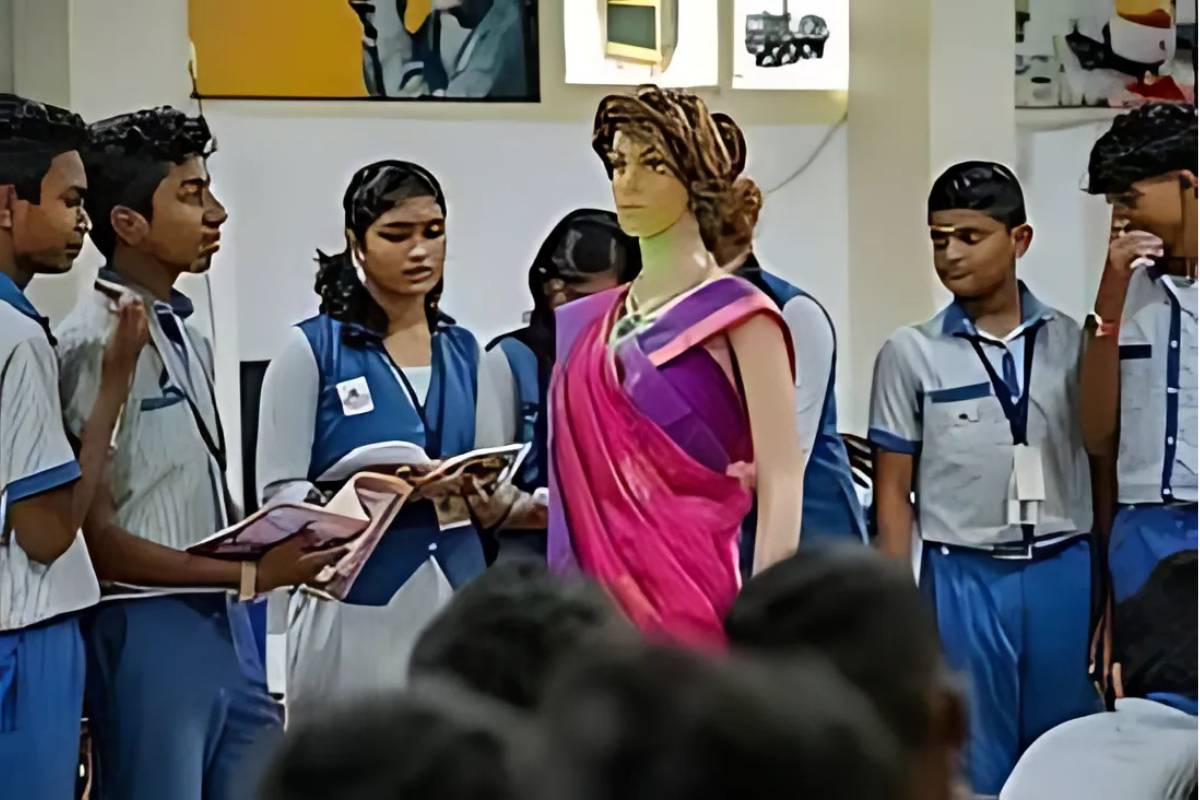Tamil Nadu’s government schools are making history by bringing cutting-edge technology into classrooms that have been left behind for a long time. This is changing the way students learn. The state’s ambitious TN SPARK initiative is more than just another educational program; it’s a brave attempt to make public and private schools more equal.
How TN SPARK is Different from Other AI Programs
TN SPARK stands for the Tamil Nadu Schools Program for AI, Robotics, and Knowledge of Online Tools. It’s not like other tech programs that get a lot of attention and then fade away. This pilot program, which starts in the 2025 school year, is aimed at students in grades 6 through 9 and will give them real-world experience with coding, robotics, and artificial intelligence.
This is where things get interesting. The program isn’t just putting computers in classrooms and calling it new. Instead, it’s making a structured curriculum that takes AI education as seriously as math or science.
Closing the Digital Divide in Tamil Nadu Schools
In India, the digital divide between government and private schools has been, to be honest, pretty big. Private schools often have smart boards, coding classes, and robotics labs, but government schools have had trouble with basic infrastructure. TN SPARK is Tamil Nadu’s answer to this problem, and it’s not a small one.
Key Program Details:
- 85 government schools in Coimbatore district are participating in the first phase
- 78 middle schools, 4 high schools, and 3 higher secondary schools included
- 880 high-tech computers dedicated to the program
- Bilingual textbooks are available in both English and Tamil
But what makes this project especially smart is that they have made bilingual textbooks in both English and Tamil. This means that students can learn difficult AI concepts in their first language, which removes another possible barrier to understanding.
Full Curriculum Design for Skills of the Future
The TN SPARK curriculum isn’t just about teaching kids how to use computers, even though that’s a big part of it. The program teaches basic computer science concepts like algorithms, flowcharts, word processing, and data visualization.
Students also get to use online learning tools that make languages, science, geography, and anatomy more fun and interactive. Think of it as mixing old-fashioned ways of learning with new digital tools that make hard-to-understand ideas easier to understand.
Students Learn About AI Applications Through TN SPARK
These kids really get excited about the artificial intelligence modules. Students learn how to use text-to-image and text-to-speech technologies, make digital art, use doodling apps, translation tools, and animation software. These lessons aren’t just in theory; students use these AI tools to make things.
Core Learning Areas:
- Text-to-image generation and text-to-speech technology
- Digital art creation and doodling applications
- Translation tools and animation software
- Visual programming through Blockly, Turtle Art, and Scratch
- HTML basics and cyber safety education
The coding part teaches students how to use simple platforms like Blockly, Turtle Art, and Scratch. These visual programming languages help students learn how to code without getting confused by complicated syntax. The program also teaches the basics of HTML and, most importantly, how to stay safe online, which prepares students to be responsible digital citizens.
How to Put It into Action and Train Teachers
The way TN SPARK is being put into action is one of the smartest things about it. Instead of hiring teachers from outside the school, the program trains current math and science teachers to teach these lessons. This method makes sure that things stay the same and helps students learn about AI and robotics in the context of things they are already studying.
Each school that takes part in TN SPARK classes sets aside one or two periods a week for them. This may seem small, but it’s actually very smart because it lets students learn these new ideas without getting in the way of their regular schoolwork.
How Students Responded and What Happened First
Teachers are saying something that might surprise people who don’t believe it: students are more excited about TN SPARK classes than about regular classes. Students aren’t just casually interested in these tech-focused periods; they actively prefer them to regular classroom lessons.
The program started with introductory sessions, but the full syllabus won’t be available until October, after the first quarterly exams. This step-by-step method gives both teachers and students time to get used to the technology before moving on to more difficult tasks.
Dealing with Problems with Infrastructure and Access
Tamil Nadu is committed to this program in more ways than just making new curricula. For a number of years now, the state has been steadily building up digital infrastructure in its public schools. In the past, schools across the state were given integrated computer systems, projectors, and smart boards as part of other projects.
The government set aside ₹400 crores to expand digital learning programs, showing a strong financial commitment to using technology in schools. This investment in the background laid the groundwork for TN SPARK to happen. You can’t teach AI without computers and the internet that work well.
A Look at National AI Education Programs
TN SPARK is not happening by itself. The central government started the SOAR (Skilling for AI Readiness) program for students in Classes 6–12. It has three structured 15-hour modules. But Tamil Nadu’s approach seems to be more thorough and hands-on than the national ones.
SOAR is mostly about AI awareness and basic programming concepts, while TN SPARK includes robotics, creative apps, and digital tools that can be used in more than one subject. This wider range gives Tamil Nadu students more hands-on experience with how to use technology.
Long-term Goals and Plans for Growth
Officials have made it clear that TN SPARK isn’t just about giving people access to new technology, though that’s a big part of it. The goal of the program is to help students learn how to solve problems and use technology so they can be ready for school and work in the future.
The choice of Coimbatore district for the pilot isn’t random either. Coimbatore is a major industrial and technology center in Tamil Nadu. It gives students a chance to see how what they learn in school can be used in the real world in their local economy.
Making Rural Students More Tech-Savvy
The most important thing about TN SPARK is that it wants to make “a tech-savvy generation capable of keeping pace with emerging digital trends, regardless of socio-economic background.” This wording makes it sound like the program is meant to change things rather than just add to them.
The bilingual approach is even more important when you think about how many of these government school students come from homes where English isn’t the first language. The program teaches difficult technical ideas in Tamil, which helps students fully understand the material by getting rid of language barriers.
Closing the Technology Gap Between Cities and the Countryside
Tamil Nadu’s rural areas have always had trouble getting good education, especially in STEM fields. TN SPARK directly addresses this by bringing advanced technology education to government schools that serve mostly rural and low-income communities.
Program Impact Areas:
- Bridging urban-rural educational disparities
- Providing equal access to advanced technology training
- Supporting students from diverse socio-economic backgrounds
- Creating opportunities comparable to private school offerings
The program’s main goal is to “guide rural students in Tamil Nadu’s government schools,” which shows how important it is to reach out to groups that aren’t getting enough help. This targeted approach could help make sure that new technologies don’t make the gap between urban and rural educational opportunities even bigger.
How it Fits into the Current Educational System
TN SPARK builds on Tamil Nadu’s past work with schools like IIT Madras to come up with new ways to teach. These partnerships have worked on AI-powered educational tools and data-driven frameworks, which have built up a base of knowledge that supports the current project.
TN SPARK’s hands-on approach to technology education fits perfectly with the state’s shift toward competency-based teaching and learning. Instead of just memorizing facts about AI and robotics, students learn how to use these technologies in real life.
How to Measure Success and Future Results
It’s too soon to tell what the long-term effects will be, but the short-term signs are good. Teachers say that their students are very interested, and the investment in infrastructure shows that state leaders are still committed. The program’s design, which includes dedicated hardware, trained teachers, and a structured curriculum, makes it look like it was planned out carefully instead of being thrown together quickly.
The timing is especially important because job markets around the world are changing very quickly due to AI and automation. Tamil Nadu is making sure that students have several years to learn these skills before they have to choose a career by starting AI education in Classes 6–9.
A Possible Model for Other States
If TN SPARK works, it could be used as a model for other Indian states that want to modernize their public schools. The program’s focus on using teachers’ existing resources, teaching in the students’ native language, and combining technology with traditional subjects makes it easy to copy.
Key Success Factors:
- Training existing mathematics and science teachers
- Providing mother-tongue instruction alongside English
- Integrating technology with traditional subjects
- Focusing specifically on government school students
The emphasis on government schools is particularly important because these schools educate most of India’s students, but frequently lack the resources that private schools can offer for technology education.
Problems and Realistic Goals
There are always problems with educational programs, and TN SPARK will probably have a lot of them. It takes ongoing technical support and money to keep 880 high-tech computers up to date and running smoothly in 85 schools. As technology changes quickly, teachers need to keep getting training.
In rural areas, internet access can be spotty, which could make it hard for students to fully use online tools and AI apps. The program’s success will depend in part on how reliable the infrastructure is beyond just the schools.
Things to Think About for Sustainability and Growth
The real test for TN SPARK will be whether it can keep up the quality as it grows to more schools and districts. Pilot programs often do better when they have a lot of resources and attention, which is harder to keep up at larger scales.
But Tamil Nadu’s history of using new technologies and ideas in schools shows that they are taking a planned approach rather than an opportunistic one. The state’s past investments in digital infrastructure make it possible for wider use to happen.
Conclusion
The TN SPARK program in Tamil Nadu is more than just another educational technology program; it’s a full effort to get government school students ready for a world where technology is changing quickly. The program fills in both short-term skill gaps and prepares students for long-term careers by offering structured, bilingual lessons in AI, robotics, and digital literacy.
The program’s focus on government schools is significant in a country where economic inequality often leads to educational inequality. If it works, TN SPARK could help ensure that a student’s socioeconomic background doesn’t affect their ability to access a cutting-edge education in robotics and AI.
















